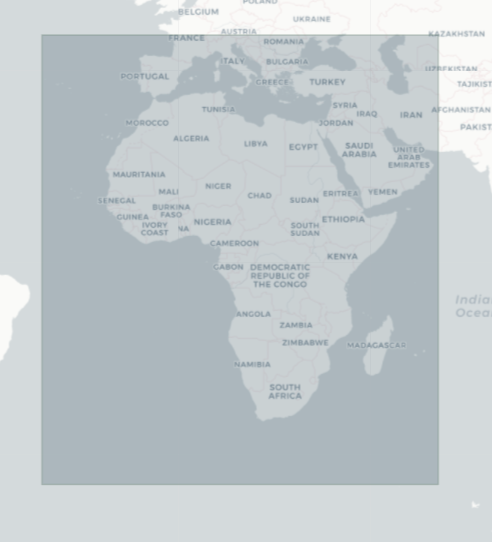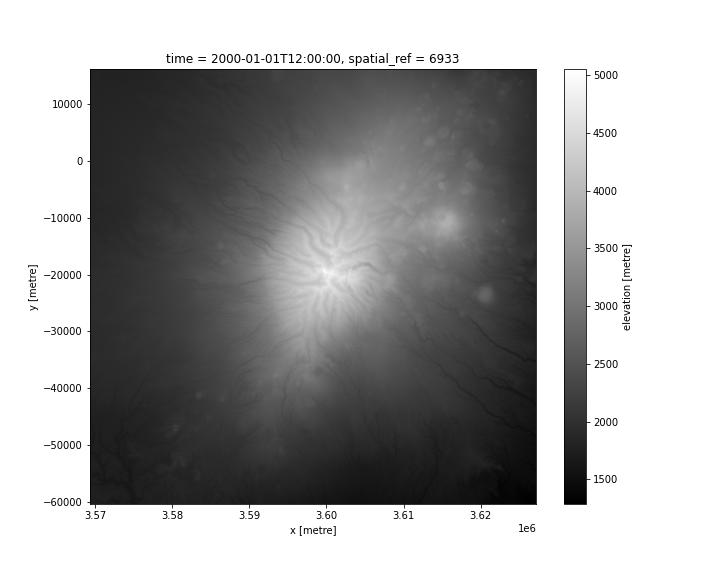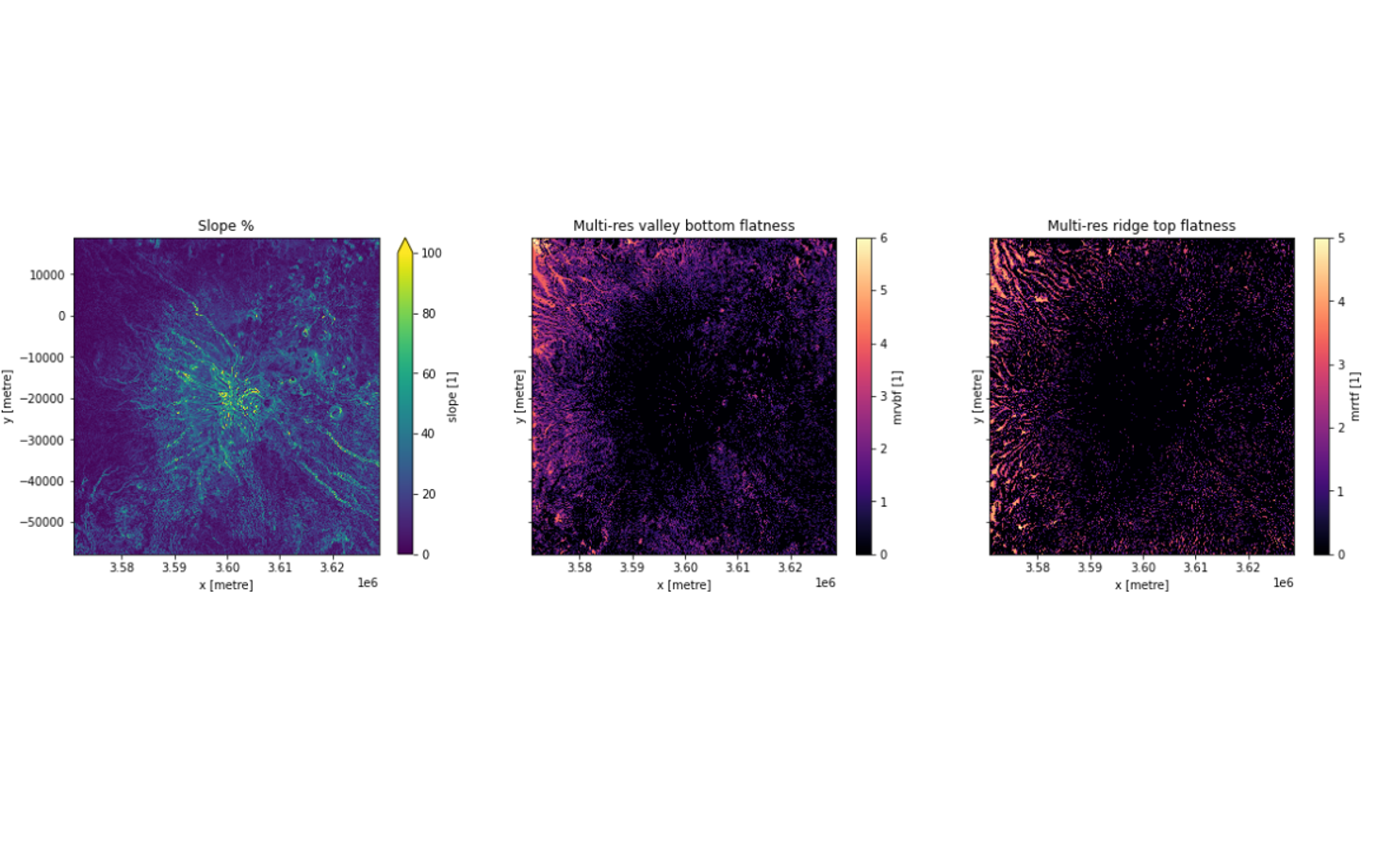Shuttle Radar Topography Mission (SRTM) 1 Arc-Second Global Digital Elevation Model and DEM Derivatives¶
Aperçu du produit¶
Contexte¶
The NASA Making Earth System Data Records for Use in Research Environments (MEaSUREs) Shuttle Radar Topography Mission (SRTM) global 1 arc second (~30 metre) DEM is archived and distributed by the Land Processes Distributed Active Archive Center (LP DAAC). This dataset is a result of a collaborative effort by the National Aeronautics and Space Administration (NASA) and the National Geospatial-Intelligence Agency (NGA – previously known as the National Imagery and Mapping Agency, or NIMA), as well as the participation of the German and Italian space agencies. The primary goal of creating this dataset was to eliminate voids that were present in earlier versions of the SRTM elevation data.
Digital Earth Africa provides free and open access to a copy of the NASA Version 3 SRTM DEM product over Africa.
Digital Earth Africa also provides free and open access to the SRTM DEM Derivatives product over Africa. These derivatives include slope, multi-resolution valley bottom flatness and multi-resolution ridge top flatness. This product was generated by Digital Earth Africa from the Shuttle Radar Topography Mission (SRTM) v3.0 1 arc-second Digital Elevation Model.
A Jupyter Notebook which demonstrates loading and using DEM datasets in the Sandbox is also available.
Spécifications¶
Couverture spatiale et temporelle¶
Relevant metadata for the SRTM DEM and the SRTM DEM derivatives products can be viewed on the DE Africa Metadata Explorer here and here.
Table 1: SRTM DEM and SRTM DEM Derivatives product specifications
Specification |
||
|---|---|---|
Nom du produit |
|
|
Cell size - X |
0.000278° (~30 m) |
30 m |
Cell size - Y |
0.000278° (~30 m) |
30 m |
Système de référence des coordonnées |
EPSG:4326 |
EPSG:6933 |
Temporal Resolution |
Multi-Day |
Multi-Day |
Temporal Extent |
2000-02-11 to 2000-02-21 |
2000-02-11 to 2000-02-21 |
Fréquence de mise à jour |
None |
None |
The specific temporal and geographic extents for the products can be explored as an interactive map on the Metadata Explorer here and here. Data is available for the regions shaded in blue.
Figure 1: SRTM DEM geographic extent

Figure 2: SRTM DEM Derivatives geographic extent

Mesures¶
Table 2: SRTM DEM and SRTM DEM Derivatives product measurements
Nom du produit |
ID de la bande |
Description |
Unités |
Type de données |
Pas de données\(^\dagger\) |
|---|---|---|---|---|---|
|
elevation |
Elevation data. |
metre |
|
|
|
mrvbf |
Multi-resolution Valley Bottom Flatness (MrVBF): this identifies valley bottoms (areas of deposition). Zero values indicate erosional terrain and values ≥1 and indicate progressively larger areas of deposition. |
|
|
|
mrrtf |
Multi-resolution Ridge Top Flatness (MrRTF): complementary to MrVBF, zero values indicate areas that are steep or low, and values ≥1 indicate progressively larger areas of high flat land. |
|
|
|
|
slope |
Slope (percent): this is the rate of elevation change. |
|
|
|
\(^\dagger\) Aucune donnée ou valeur de remplissage.
Traitement¶
The NASA Version 3.0 SRTM DEM is a void filled dataset. The missing data in the National Geospatial-Intelligence Agency (NGA) Version 2.0 SRTM DEM was filled using topographic data from non-SRTM sources. The primary fill elevation data was from the Terra Advanced Spaceborne Thermal Emission and Reflection Radiometer (ASTER) Global Digital Elevation Model Version 2.0 (GDEM2) and the secondary fill elevation data from the USGS Global Multi-resolution Terrain Elevation Data (GMTED2010) elevation model or the USGS National Elevation Dataset (NED). The SRTM Version 3.0 processing steps are detailed in The Shuttle Radar Topography Mission (SRTM) Collection User Guide.
The SRTM DEM Derivatives were generated by Digital Earth Africa from the SRTM v3.0 Digital Elevation Model using gdaldem for the percent slope and SAGA GIS tool (Version: 2.3.1) for the multi-resolution valley bottom flatness (MrVBF) and multi-resolution ridge top flatness (MrRTF). The scripts used to generate the derivatives are available here.
Médias et exemples d’images¶
Figure 3: SRTM DEM elevation data for Mt. Kenya

Figure 4: SRTM DEM Derivatives for Mt. Kenya

Références¶
G., Rosen, P. A., Caro, E., Crippen, R., Duren, R., Hensley, S., Kobrick, M., Paller, M., Rodriguez, E., Roth, L., Seal, D., Shaffer, S., Shimada, J., Umland, J., Werner, M., Oskin, M., Burbank, D., & Alsdorf, D. (2007). The Shuttle Radar Topography Mission. In Reviews of Geophysics (Vol. 45, Issue 2). American Geophysical Union (AGU). https://doi.org/10.1029/2005rg000183
The Shuttle Radar Topography Mission (SRTM) Collection User Guide
License and Acknowledgements¶
The SRTM DEM is available under a CC-BY-4.0 license.
The Digital Earth Africa SRTM DEM Derivatives product is provided free of charge, under a Apache License 2.0 license.
Accès aux données¶
Amazon web services S3¶
The SRTM DEM and SRTM DEM Derivatives are available in AWS S3.
Table 3: SRTM DEM and SRTM DEM Derivatives AWS data access details
Détails sur AWS S3 |
||
|---|---|---|
Product |
SRTM DEM |
SRTM DEM Derivatives |
Seau ARD |
|
|
Région |
|
|
Le seau se trouve dans la région AWS af-south-1 (Cape Town). Des spécifications de région supplémentaires peuvent être appliquées comme suit :
aws s3 ls --region=af-south-1 s3://deafrica-input-datasets/
The SRTM DEM file path is: strm_dem/dem_srtm. The SRTM Derivatives file path is: srtm_dem/dem_srtm_deriv.
Services Web de l’OGC (OWS)¶
The SRTM DEM and SRTM DEM Derivatives are available through DE Africa’s OWS.
Table 5: OWS data access details.
Détails de l’OWS |
|
|---|---|
Nom |
DE Africa Services |
URL des services cartographiques Web (WMS) |
|
URL du service de couverture Web (WCS) |
|
Noms des couches |
|
Les détails de Digital Earth Africa OWS peuvent être trouvés sur https://ows.digitalearth.africa/.
For instructions on how to connect to OWS, see this tutorial.
Open Data Cube (ODC)¶
The SRTM DEM and SRTM DEM Derivatives can be accessed through the Digital Earth Africa ODC API, which is available through the Digital Earth Africa Sandbox.
ODC product names: dem_srtm, dem_srtm_deriv
Specific bands of data can be called by using either the default names or any of a band’s alternative names, as listed in the table below. ODC Datacube.load commands without specified bands will load all bands.
Table 6: ODC products dem_srtm and dem_srtm_deriv band names
Product |
Nom du groupe |
Noms alternatifs |
Valeur de remplissage |
|---|---|---|---|
|
elevation |
NaN |
|
|
mrvbf |
NaN |
|
mrrtf |
NaN |
|
|
slope |
NaN |
|
Informations techniques¶
The Kinematic Global Positioning System Geodetic field surveying method was used to validate SRTM data. About 70,000 kilometers of survey lines were collected. The data was used to model long-wavelength error sources. In addition, NASA’s JPL deployed corner reflectors during the SRTM mission which were deployed with precisely measured coordinates and served as control points in the SRTM data.
Known issues in the NASA SRTM are described in the following publication:
Rodriguez, E., C. S. Morris, and J. E. Belz (2006), A global assessment of the SRTM performance, Photogramm. Eng. Remote Sens., 72, 249–260. https://doi.org/10.14358/PERS.72.3.249.